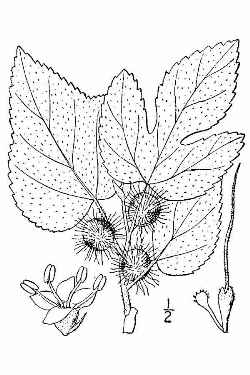Paper Mulberry
Scientific Name: Broussonetia papyrifera (L.) L'Hér. ex Vent.
Synonym: Morus papyrifera, Papyrius papyriferus
Family: Moraceae

Britton, N.L., and A. Brown. 1913. Illustrated flora of the northern states and Canada. Vol. 3: 20. Courtesy of Kentucky Native Plant Society. Scanned by Omnitek Inc.
Sunset®: 3-24
USDA: 7-12
Heat Tolerance: Good
Sun Exposure: Full sun
Origin: Northeastern Asia
Growth Habits: Small deciduous tree, fast growing, up to 50 feet tall (15 m), 40 feet wide (12 m), somewhat untidy looking; the leaves on the young tree are lobed, up to 12 inches long (30 cm); adult trees have smaller leaves, generally entire.
Watering Needs: Little water
Propagation: Suckers, heeled cuttings, self seeds if you have male and female trees close by
The Paper Mulberry is a good shade tree in difficult situations. In good soils and with plenty of water, it tends to sucker. It is considered invasive in Tennessee. The name "paper mulberry" comes from the fact that it yields a fine fiber from its inner bark used to make paper or Polynesian tapa cloth.
Blooming Habits:
This tree is dioecious. Both male and female trees have inconspicuous blossoms in mid-spring. The male flowers are long twisted catskins. The female trees bear small red fruits that are eaten by the birds. They are dry and unpalatable to humans
Desert-Tropicals is dedicated to provide gardening advice, gardening ideas, and information about flower of all kind for landscape and collections.We try to check carefully the identification of the plants on the illustrations as well as the other information from the page, but occasionally errors do occur. if you notice anything that needs to be changed please contact us.Thanks.
© 1998-2020 Philippe Faucon, All Rights Reserved.